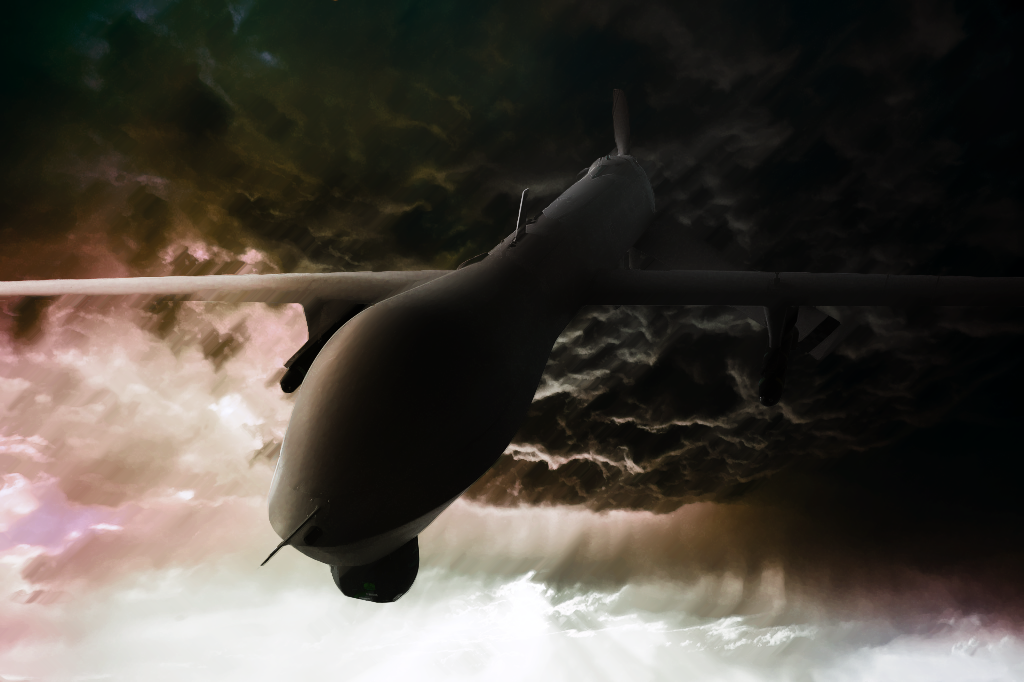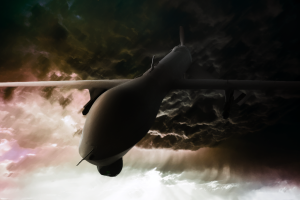The Face of Drones
 By Jared Rodriguez, Flickr CC
By Jared Rodriguez, Flickr CC

From a Western point of view, the recent use of drones to supplace human soldiers fighting terrorist groups in the Middle East induces nothing but relief. Their soldiers aren’t going to fight. When you spin drone warfare on its head, however, and see it from the eyes of its accidental victims, the robots paint quite a different story. The disconnect between the two worlds – ‘west’ and ‘east’ – exacerbates this problem, as neither side can see the reasoning behind the other’s views – only their own fears and hopes.
Drones – unmanned aerial vehicles that can be remote controlled and can carry and drop bombs – have been used in Middle Eastern countries as an alternative to ground troops. The Obama administration specifically has been a fan, as seen by the fact that it has often argued that drones have “relentlessly [targeted] al-Qaeda leadership” and are legally sanctioned in terms of international humanitarian law” (Miller). Drones are also less expensive than manned operations, since “it costs anywhere from $18,000 to $169,000 per hour to operate a manned aircraft, [which is] 6 to 42 times more expensive than it is to carry out a drone strike” (Bowes and Cohen). Drones can also take more risks than manned vehicles, since they do not put any pilots in danger’s way. This is especially favourable for the American domestic population whose memories regarding the Iraq and Gulf Wars, as well as the fighting in Afghanistan, are plagued with tragedy and death.
The encouraging use of drone warfare took a hit in 2011, however, “when a strike in Pakistan killed two Western civilians who had been taken hostage by al-Qaeda” (Miller), despite U.S. claims that very few civilians are ever killed by drones. It appears an American needed to die before some light was shed on the subject of drone warfare. This, however, did not fully stop the U.S. administration, who still flies drones “from bases in Turkey, Kuwait, Saudi Arabia, the United Arab Emirates and Qatar” (Kreps). Nevertheless, the U.S. insists that no international laws are broken.
The legality of U.S. drones becomes more complex when you understand that, for the CIA, “Syria remains a ‘denied’ area” (Miller). Drones are the only way to fight terrorist groups, including Daesh, without establishing a presence there. Nevertheless, drones do not steer clear of the law just because they are unmanned. Furthermore, Amnesty International’s “unofficial reports, […] have suggested that hundreds have been killed in Pakistan alone, with up to 200 children killed.” The Amnesty International report goes as far as stating that “the US may have committed war crimes and should stand trial for its actions” (McVeigh).
People in the Middle Eastern also have not forgotten the (‘accidental civilian’) deaths in Iraq and Afghanistan, where “the Iraq Ministry of Health […] found 400,000 excess deaths, 151,000 by violence” (Tirman). Non-combatants have every right to fear more conflict in the region; but many also fear the West as such, especially the U.S.. The question isn’t whether the drones are killing militants, but rather whether the ensuing deaths of civilians are resulting in more radicalization and thus the creation of more militants.
Can the recent increase in anti-Americanism be attributed to these deaths, or should that connection be less apparent, now that drones are being deployed over soldiers? Which military strategy causes more radicalization in the local populations affected?
Allegations of American military corruption in Iraq, including looting and harming of civilians as well as the statistics of the grand amounts of death that occurred there, have no doubt created a “revenge effect” (to use Condra et al.’s terminology) among civilians – arguably pushing some to terrorism. There is precedence to this in Afghanistan, where the original U.S. backing of the Mujaheddin (many of whom later joined Al-Qaeda) had ended up encouraging more extremism.
Discussing the topic and its effects on the ‘clash of civilizations,’ political theorist Stephen Walt says, “[The U.S. does] things that make people in [the Middle East and its environs] really angry. People in the United States don’t know about [our military actions]. People out there know about it and so a few of them […] decide to do something in response. […] They organize a terrorist plot. And Americans back here are not aware of what we are doing over there and say, ‘Look at those horrible people, they hate us, they hate our freedoms'” (Walt). There are fears in both societies, and when citizens are ignorant as to what is happening, these fears only proliferate.
As Walt explains, the responses of civilians to unnecessary death can be terrorism or other form of militarization. However, the collateral damage caused by drones and poor soldier policy may not be the only reason for that. McGill professor Malek Abisaab offers a different perspective on violence leading to radical effect: “the restructuring of the political system” (Abisaab). He explains that drones are not as much of a worry compared to American Iraqi policy as “looting, [which] could be a factor [of American troops in Iraq]. But the main reason for growing resentment against Americans was the restructuring of the government, […] resented by both Sunni and Shia” (Abisaab). Yes, drones are not perfect but they will cause less radicalization and hatred than the American policy in Iraq, so long as the societal structure of where the drones are implemented is not drastically altered.
Speaking on October 23 at a U.S. Congress hearing, a Pakistani child who claims his mother had been killed by a drone strike, said “Now I prefer cloudy days when the drones don’t fly. When the sky brightens and becomes blue, the drones return and so does the fear. […] Education isn’t possible as long as the drones circle overhead” (McVeigh). Even if the drones do not cause collateral damage, they still have a lasting, negative affect on the local society, which could be a disturbing effect, much like the political upheaval that has overtaken Iraq. Hatred can be the result of both military strategies, but we should ask, which one’s costs outweigh the benefits? Human interaction with traumatized victims of war can in fact be beneficial to the image of the U.S. and other Western countries, but kind soldiers are often an unattainable ideal.

To clarify on the effects of ground troops, political theorist Stephen Walt adds, “It depends enormously on what the ground troops are doing and what policy they’ve adopted there. The way in which the American army was behaving in the first several years of the occupation of Iraq […] did not [help] endear themselves to the local population. […It] probably […] did just as much damage to our relationships there as relying on drones. […] I can make a case for the question that ‘Yes, a well trained, very sensitive, very skilfull counter-insurgency [approach] might be more effective than just trying to [do] this by drones” (Walt).
Studies on radicalization find that, “in Afghanistan, we find strong evidence that local exposure to civilian casualties caused by international forces leads to increased insurgent violence over the long-run. There is no evidence that out-of-area events – errant air strikes for example – lead to increased violence” (Condra et al.).
The lack of evidence however could simply be put down to a lack of intelligence in the affected areas – again, Syria is a denied area for the CIA. Even the UN office in Iraq has used “passive surveillance” methods, capturing only part of the total picture. Consequently, domestic American support for drone usage could easily be blamed on ignorance. The Obama administration has in fact stated that “in terms of overall support, individuals went from the control levels of support around 52 per cent to between 29 and 27 per cent, when those questions introduced uncertainty about combatant status and the potential impact of drone strikes on civilians.” When Americans learn about causes behind radicalization, their opinions shift dramatically.
All in all, drones are an effective and justified tool to combat militants; however they can also be seen a quick fix to a problem that requires much more attention. Whilst the governments implementing them must be cautious towards laws, disturbance, hatred and civilian death, they are also a great tool to appease their domestic population. Drones are for soft-liners and this, depending on circumstance, may or may not be a bad thing.
Abisaab, Malek. Personal Interview. 1st February 2016.
Bowes, Jonathon and Cohen, Matthew. “Is Drone Warfare Ethical?” The Stanford Daily. 16th February 2015. Web. 20 January 2016. .
Condra, Luke N. et al. “The Effect of Civilian Casualties in Afghanistan and Iraq” The National Bureau of Economic Research. July 2010. Journal. 20 January 2016.
Miller, Greg. “US Launches Secret Drone Campaign to Hunt IS Leaders in Syria.” National Security. Washington Post. 1 September 2015. Web. 20 January 2016.
McVeigh, Karen. “Drone Strikes: Tears in Congress as Pakistani Family Tells of Mothers Death.” The Guardian. 29 October 2013. Web. 20 January 2015.
Krep, Sarah. “Do Americans Really Love Drone Strikes?” The Washington Post. 6 June 2015. Web. 20th January 2015.
Tirman, John. “Major Studies of War and Mortality.” Iraq: the Human Cost. 11 October 2006. Web. 20th January 2016.
Walt, Stephen. Conference Interview. 21 January 2016.
